Pam Calvert's Blog, page 2
April 21, 2015
Picture Book University EXTRA! Take a Children's Writing Course
 Hope all of you are busy writing outside on these beautiful spring days! As it happens, I've just had the wonderful experience of participating as a judge for a picture book contest. I read about 100 manuscripts and it gave me some ideas on supplemental material blog posts I can give beginners. SO...fair warning to all of my regular readers. PBU EXTRA is for beginning writers. If you've been writing for a while, these won't be for you. I do have several more regular PBU posts to do, so please watch out for those in the near future.
Hope all of you are busy writing outside on these beautiful spring days! As it happens, I've just had the wonderful experience of participating as a judge for a picture book contest. I read about 100 manuscripts and it gave me some ideas on supplemental material blog posts I can give beginners. SO...fair warning to all of my regular readers. PBU EXTRA is for beginning writers. If you've been writing for a while, these won't be for you. I do have several more regular PBU posts to do, so please watch out for those in the near future.I've had many people come to me, asking for advice--from friends to friends of friends to my critique clients. I can tell by the first page whether someone has just decided to venture into this business sight unseen--meaning with no training at all. I want to make it clear that writing picture books, although seemingly simple, is anything but easy. In fact, I had been published in Highlights for Children (here's one of my stories: Just My Size) and I still couldn't break into picture books. Why? Because I'd had no training in writing them! I didn't know how to set them up, even though I'd read a lot of them.
If you want to get published, you will have to invest in this as a career. If you don't want to be bothered with extra education, then you really need to think of something else to do. I mean, if you're a professional, didn't you go to college to learn your trade? A doctor goes to med school, a lawyer goes to law school, a business person gets their business degree. Why in the world wouldn't a picture book author learn the art of picture book writing? Yet time and time again, I see picture books written by people who obviously have never taken a class about writing for children.
Is this you?
Are you writing and writing and writing, sending out manuscript after manuscript and either getting silence or rejection? Or are you the person who on a whim has this funny joke or idea and thinks kids will like it? So you write it out and feel it must get published. Your kids laughed after all!
If you think you don't need training, I will wish you great good luck and send you on your way. But if you just didn't realize there were classes out there, and you really want to succeed, then I have some great advice for you!
1. Take Institute for Children's Literature--I cannot be any more clear or loud about this school. It
 will teach you everything you need to know about writing for children. I say start here because if you don't, your learning curve will be high and long. They will pair you up with a published author that will mentor you through many manuscripts and you will start "seeing" like a child and therefore, write better for them. I was published in a children's magazine only 9 months after taking this course! But I couldn't write picture books well, so if you want to write those...you will need even more education.
will teach you everything you need to know about writing for children. I say start here because if you don't, your learning curve will be high and long. They will pair you up with a published author that will mentor you through many manuscripts and you will start "seeing" like a child and therefore, write better for them. I was published in a children's magazine only 9 months after taking this course! But I couldn't write picture books well, so if you want to write those...you will need even more education.2. Do my free PBU workshop--This is a great start for you and it won't cost you a cent! I would advise doing the lessons one at a time and at the end of each lesson, do the assignment. They can be done at your own pace, but DO THEM! By the time you're finished, you will have a better understanding of how to set one up. And you will have read and studied over 80 picture books! After you're done with this...you STILL need more help! (Sorry...but you will...)
3. Take a picture book class--The one I can endorse is Anastasia Suen's Intensive Picture Book Workshop. She will go through one of your manuscripts through this intense class while you and seven others critique as well. It's amazing how she can fine tune a manuscript. I put PRINCESS PEEPERS through her second workshop and sold it! I would never have been able to write that manuscript if I hadn't taken the first course, though.
4. Other classes--I've heard from around the blogosphere of other picture book classes. I cannot vouch for them, but I know good things about the teachers themselves and they are either editors or highly accredited authors. So I will list them here:
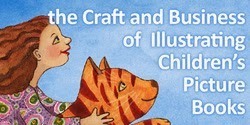 Picture Book Academy--Many different authors participate as mentors.
Picture Book Academy--Many different authors participate as mentors.Writer's Digest picture book workshop--ongoing classes. Check to find availability.
The Loft--picture book course--taught by picture book author, Molly Beth Griffin
Revising and Reimagining Your Picture Book--by Harold Underdown and Eileen Robinson. The workshop is full but they are offering a discount for those who want to join in on the recordings.
5. Join a critique group--Only after you've done all that, NOW you are ready for a critique group. You have to get the basics down first before others can even start making your work better. A great way to get a group is in Anastasia Suen's class. It's set up like a critique group and in my class, we started one. ALL of my fellow critique group members became published: Katherine Rollins, Barbara Kaninnen, Dianne White. How's that for rate of return?
6. Get a professional critique--I only advise this if you've done all of the above yet you still can't get an agent and you still can't get published. Having a professional look at your work is amazingly better than having someone on your writing level review it. A GREAT way to find out if you have a good story is to join Rate Your Story. For a minimal annual fee, you can have one manuscript a month reviewed by a professional. If you score a 6 or better, I'd say your manuscript is worth paying a professional to help you.
I happen to offer a professional critique service. I must say that all those who do pay for my service are well on their way to achieving their dream. Why, you say? Because people who are not ready to invest in their work are not ready to succeed. I can say I'm very proud of all of my clients. They really are a cut above the rest! It's fun being the mentor to these talented writers. :)
I hope this post is helpful to you. I can honestly say that over the years, those who don't give up do get published. They keep honing their craft, keep learning, and one day...they get that fabulous call.
Someone wants to publish your work!
Crack open the celebratory libations! HOORAY!
Happy writing,
Published on April 21, 2015 10:05
March 19, 2015
Rate Your Story Contest
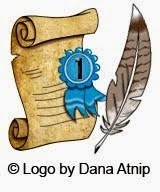 There's a cool contest out there I wanted to let you know about from RATE YOUR STORY. If you don't know about this awesome, informational website and tool, you should check it out. They have a wonderful newsletter jammed with insider information as well as the ability for you to get your stories rated by professional authors--every month!
There's a cool contest out there I wanted to let you know about from RATE YOUR STORY. If you don't know about this awesome, informational website and tool, you should check it out. They have a wonderful newsletter jammed with insider information as well as the ability for you to get your stories rated by professional authors--every month!I am one of the authors who participates in rating these stories--for free! So, if you have a wonderful manuscript just waiting out there, send it in! A win in a contest like this will get you noticed as having something that an agent/editor might want.
If you'd like to check it out, go here: RATE YOUR STORY WRITING CONTEST

Some of the things a judge will look for:
1. Marketability--is it unique? Will children love it?
2. Emotional connection--did it make them feel something? Laugh? Cry? Bond with the characters?
3. Understanding of how to write picture books--meaning, the author thinks in pictures and the story will be enhanced by illustrations. In fact, without pictures, it wouldn't be a whole package.
4. Under 600 words. This is not a hard and fast rule, but I've found in rating lots of stories and through my own critique service that if a story goes over 600-650 words, usually, it needs to be cut or the story needs to be restructured.
5. Style elements. How does the author use these to delight their readers? Are they cleverly used? If you're not sure what I'm talking about, please read my post about style elements here: PBU Style Elements.
6. A unique, twist ending--something that surprises the reader, makes them say, awww, or just knocks it out of the park!
If you want examples of stories I think would help you and are wonderful to study, go through my PBU workshop and see the picture books I highlight. All of them are masterpieces in my opinion.
You have until March 31st to get your entries in!

Happy writing and...
GOOD LUCK!
Published on March 19, 2015 11:46
March 1, 2015
SOLD! My New Character Driven series!

Just wanted to share that I will be having a brand new princess series coming by Two Lions! We finally decided on the name--don't get hung up on a character's name. Over the many picture books I've written, only one actually has the name I came up with in the beginning (Princess Peepers).
So, it's entitled, BRIANNA BRIGHT, BALLERINA KNIGHT! It's about a spunky princess who's searching for her talent.Through lots of trial and error (re: much slapstick), she ends up with TWO!
How did I get a new series? By holding onto the tenets I found by studying these types of books. I knew publishers needed them, and I set out to find a story that hasn't been written. UNIQUENESS is key! Plus humor helps. My spunky princess is funny and my editor wants more adventures.
If you want to write a character driven story, please read my lesson on this topic and do the assignment! Character Driven Picture Books. Study these types of books!
And NEVER GIVE UP!
Published on March 01, 2015 17:38
July 30, 2014
Picture Book University: Kid Focus

If you've done all my lessons up to now, you should have a pretty good grasp of how to write a picture book. You've read at least 85 picture books--right? If not, go back and do the lessons you missed. ;-)
Now I want to draw your attention to your latest WIP (work in progress). I've noticed the new writer often forgets who their audience is--KIDS! Sometimes, a grandmother will write about characters suffering from arthritis or the plot will focus around adults and adult wants and needs. Or the jokes will be funny only to grown ups. That has no place in children's literature. Sure, you'll see the double entendre here and there just for adults (even the ending of Princess Peepers has a pun specifically for adults), but the focus is always kid centered. I think of it as a camera lens. Is your camera on yourself? The parent? The grandparent? If so, bring the lens down...keep going...yes, there! To that kindergartner running around your house. See the world the way they see it. If your manuscript doesn't pass the kindergartner test, you need to go back and revise.
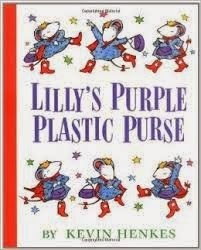 If you don't have a child to study, I suggest you get one. Rent a kid! Ha! Well, not really, but maybe you could go out with your friend and ask to bring along their kindergartner/first grader. Volunteer at church to teach Sunday school for the K-2 crowd. My youngest child is 13 now and I no longer have elementary kids around, but I've always taught K-3rd graders at church. In fact, I teach K-3rd on Wednesdays and 4th-6th on Sundays--I know my audience. I watch and observe them. I know how they think. Don't have a church? Volunteer at a local library for reading time on the weekends (or weekdays if you don't have a 9-5 job). It's important for you to understand what's important to your audience. Otherwise, you have no business writing for them.
If you don't have a child to study, I suggest you get one. Rent a kid! Ha! Well, not really, but maybe you could go out with your friend and ask to bring along their kindergartner/first grader. Volunteer at church to teach Sunday school for the K-2 crowd. My youngest child is 13 now and I no longer have elementary kids around, but I've always taught K-3rd graders at church. In fact, I teach K-3rd on Wednesdays and 4th-6th on Sundays--I know my audience. I watch and observe them. I know how they think. Don't have a church? Volunteer at a local library for reading time on the weekends (or weekdays if you don't have a 9-5 job). It's important for you to understand what's important to your audience. Otherwise, you have no business writing for them.The best example of an author who really gets the mind of a child is Kevin Henkes. He's a great author to study for kid centered stories. One of my favorite picture books is Lilly's Purple Plastic Purse. It's a wonderful book to study for other elements, too, such as rhythm, plot, etc., but for our purposes here, I'm going to show you how Henkes makes sure his camera is on the child.
Lilly's Purple Plastic Purse by Kevin Henkes
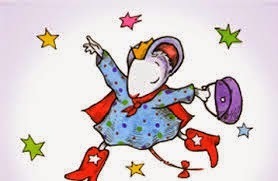 Genre: Character driven, humor
Genre: Character driven, humorSynopsis: Lily loves a lot of things, especially her teacher, Mr. Slinger. That is until he takes away her favorite purse. In order to seek revenge, Lily draws nasty pictures of her teacher, but her teacher, in turn, writes a sweet note which makes Lily feel bad. In the end, she apologizes, making everything better.
I'm not going to go over plot and style elements but I'd advise you to do that! You could learn a lot about rhythm and repetition from this story.
Kid Centered Elements:
Lilly loves things a child would love--school, pointy pencils, squeaky chalk, shiny hallways, etc. and her teacher. We don't see her loving things like a massage of her sore hands. If you have a character that needs a massage--please revise this. Children are like rubber. They don't get aching muscles!Lilly describes her teacher as a child would--about things a child would like--his interesting glasses and shirts, how he greets the class, the inviting way he arranges the classroom, and the snacks! Lilly pretends to be her teacher--she plays with her brother--exactly what a child would do at that age.Lilly liked to draw--and the drawings are very much like what a child this age would do.She rides the bus, and raises her hand and volunteers in the classroomLilly gets a wonderful, musical purse that she adores. This is so much like what a kid would care about and become obsessed over.Lilly indeed obsesses over this prized object and gets in trouble with her beloved teacher. She can't wait for show and tell to show off her purse.Lilly is embarrassed, but after she loses her beloved purse, she almost cries and then she gets angry exactly how a child would. I know. I've taken up things from children before and if it's special, it's hard for them not to cry and get upset.Lilly seeks revenge like a child would--Lilly loved to draw pictures of her teacher--so she drew a mean one that called him a big fat mean Mr. Stealing Teacher. All the things she writes shows her emotions--she deals with her anger and grief exactly the way a 5 year old would. Even though the teacher is nice to her when he gives her back the purse, she's still angry and tells him so by saying she doesn't want to be a teacher when she grows up (when earlier she wanted to be like him.)But when Lilly gets a sweet note from her teacher, she feels bad just like a child would when they thought about their actions.I'm not going to go through the whole thing, but my biggest suggestion to you is if you haven't read this book, please do. Unfortunately, these days, editors are not wanting books of this length. I think it's sad because the character can't be shown eloquently enough without many scenes and words like this. Oh well! I can't change the system. Keep your stories to 500 words or less and keep them KID CENTERED.
Assignment 9:
Check out ten books at the library. Some great authors to look at for kid centered perfection are Kevin Henkes, Tom Lichtenheld, Lauren Child, Doreen Cronin, Kelly DiPucchio,
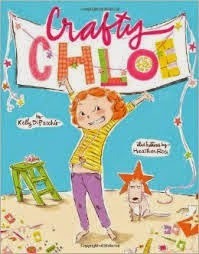 and Kate McMullan. Write a plot synopsis for each one and identify how the author's camera lens is focused on the child.Write elements which are very kids centered. Are there some that are not? Can you think of reasons why the adult-like element might have been allowed? (Usually there are good reasons.)Take a look at your WIP. Is it kid focused? Are parents, grandparents, aunts, uncles, little old lady from down the street overwhelming the story? Can you replace a parent with a sibling to take the story down to a more kid centered focus? Are you truly looking through a child's camera lens? Are parents making jokes and not the child?
and Kate McMullan. Write a plot synopsis for each one and identify how the author's camera lens is focused on the child.Write elements which are very kids centered. Are there some that are not? Can you think of reasons why the adult-like element might have been allowed? (Usually there are good reasons.)Take a look at your WIP. Is it kid focused? Are parents, grandparents, aunts, uncles, little old lady from down the street overwhelming the story? Can you replace a parent with a sibling to take the story down to a more kid centered focus? Are you truly looking through a child's camera lens? Are parents making jokes and not the child?If you know some stand out kid centered picture books, please post them below. This might help your fellow picture book writers pick out some great examples!
As always, if you like this post, please hit the like button below or the twitter bird! Share!
Do you want to see other PBU posts? Click here: PBU
Happy reading and writing!
Published on July 30, 2014 10:30
April 2, 2014
Picture Book Analysis: Daddies Do It Different by Alan Lawrence Sitomer
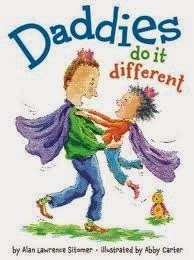 In honor of rhyming Wednesday, I've decided to do a picture book analysis of a non-rhymer that has rhythm--so much so that it can be classified as poetry. And if you want to write something like this, you need to do it well, so let's see why I think this book is so great structurally.
In honor of rhyming Wednesday, I've decided to do a picture book analysis of a non-rhymer that has rhythm--so much so that it can be classified as poetry. And if you want to write something like this, you need to do it well, so let's see why I think this book is so great structurally.Today's book is entitled, Daddies Do It Different by Alan Lawrence Sitomer.
SPOILER ALERT! My picture book analyses will reveal the climax/ending to every story. So be forewarned!
Genre: Journey, Cycle of the Day, Rhythmic text
Synopsis: A child relates all the things Daddy does differently than Mommy throughout the day but there's one thing they do exactly the same.
Plot elements: A Cycle of the Day story.
In the morning, getting dressed--ways Daddy is different from Mommybreakfast timegoing shoppingmaking lunchgoing to the parkbirthday partiesplaying dress upbath timebed timehugs and kissesTwist: All through the book, Daddy does everything differently but in the end, Mommy and Daddy both love the child just the same. A touching, sweet ending! If you get your audience to say ah...usually, you'll have a winner.
Throughout the book, there is a repeating phrase of "But daddies do it different." Which binds the text together and children love to be able to join in this repeating phrase. Although this isn't a rhymer, the text is rhythmic: "When I leave the house with Mommy, she packs a tasty snack, brings a bit of juice, and takes an extra sweater." Can you feel the rhythm here? And then the next line leads into the repeating phrase: "But daddies do it different..."

Style Elements:
Lines have catchy beats.visual humor throughout (in the scene above, daddy is putting bananas up his nose to make the child laugh.)Use of active, interesting verbs: jingles, gargles, whupVisually interesting--there's an active, fun picture on every page, (eg; Daddy has bubbles on his head in a room full of bubbles in the tub with the dog joining in the fun).Use of made-up words for rhythm, (eg. "He tickles me so much, I get crazy-hyper-nuts")Use of similes/metaphors, (eg, "we jump like kangaroos; make a fort of waffles, drives like a race car, etc.)Sweet, twist endingIf you can think of a catchy repeating phrase and can do a rhythmic story line with lots of action on a subject that hasn't been done, you'll have a winning picture book every time.
If you like these posts, feel free to click the like button below or tweet it to your friends. Next up, I will start back with Picture Book University, lesson 9. My school visit schedule is winding down--only two more to go this season, so stay tuned!
Published on April 02, 2014 10:02
October 31, 2013
New Rumpelstiltskin Puppet and School Visit Tip!
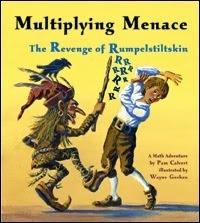 Sorry I've been out of the loop. It's school visit season and I'm BUSY! But I will do two more PBU posts to finish out the workshop this month, and then I'll do some PBU tips until next summer where we'll have a PBU 2.
Sorry I've been out of the loop. It's school visit season and I'm BUSY! But I will do two more PBU posts to finish out the workshop this month, and then I'll do some PBU tips until next summer where we'll have a PBU 2.Anyway, I just wanted to share my newest excitement and a tip for you pros out there doing school visits. I had the privilege of seeing a Mother Goose puppeteer at work at a school where they contracted five authors for one big day of reading for their students. I always wanted to have a presentation that wowed the K-2nd grade set with my math books, and although I am dynamic in my presentation where I act out the part of Rumpelstiltskin to them, I noticed how mesmerized kindergartners were with Mother Goose. Why? Because she had...PUPPETS! Her words weren't unique or even inspiring, but the puppets amazed the kids.
A huge light bulb exploded above my head. HA! That's when I knew I needed puppets to enhance my performances for the younger set.
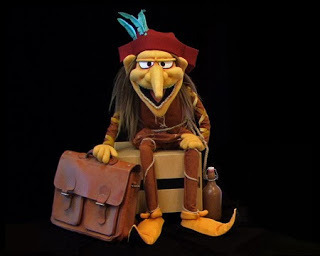 In my math performance, I teach 1st-3rd grade how to multiply by using a funny part in my book, Multiplying Menace. In order to teach multiplication, I now use finger puppets so they can see the concepts. After we finish reading the book, I give each child a worksheet (could be up to 150 kids--teachers help with this), that has a face without a nose on the sheet--and I tell them this is their face and they are to draw hair on it. THEN I tell them that Rumpelstiltskin is going to visit their school. Usually, they'll squeal with delight until I ask them do they REALLY want Rumpelstiltskin to visit? Their squeals turn to scared giggles. At this point, I whip out my Rumpelstiltskin puppet, and he wreaks havoc on the children's noses using his multiplication stick. They LOVE this! We do the multiplication on a document camera where they figure out how many noses he's multiplied on their face. I also use students to be Rumpelstiltskin's minions. It's so much fun!
In my math performance, I teach 1st-3rd grade how to multiply by using a funny part in my book, Multiplying Menace. In order to teach multiplication, I now use finger puppets so they can see the concepts. After we finish reading the book, I give each child a worksheet (could be up to 150 kids--teachers help with this), that has a face without a nose on the sheet--and I tell them this is their face and they are to draw hair on it. THEN I tell them that Rumpelstiltskin is going to visit their school. Usually, they'll squeal with delight until I ask them do they REALLY want Rumpelstiltskin to visit? Their squeals turn to scared giggles. At this point, I whip out my Rumpelstiltskin puppet, and he wreaks havoc on the children's noses using his multiplication stick. They LOVE this! We do the multiplication on a document camera where they figure out how many noses he's multiplied on their face. I also use students to be Rumpelstiltskin's minions. It's so much fun!Here's a few pictures of my puppet. He was pricey as I used a puppet artist who used to work for Jim Henson, but it's worth it. Four days worth of school visits will pay for the puppet, but the puppet has already helped me book more new visits for next year! Worth every cent!!!
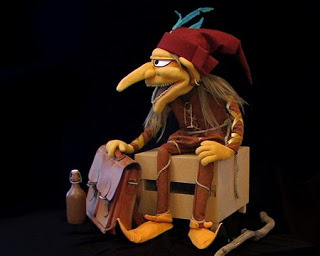
If you're interested in getting a puppet for your book, here are some worthy creators to check out:
Russ WalkoLuna's PuppetsAxtell ExpressionsPavlov's PuppetsJames Kemp Puppet Building
My creator took around 5 months to complete--he was from Creature Clones (the artist did the professional photos for me) and he has a year wait time, mostly. Other makers might not be that inundated with work, so you may want to check with them if you're in a hurry.
If you have any questions about school visits, feel free to post!
Published on October 31, 2013 10:32
September 10, 2013
Picture Book University: Creative Nonfiction

Today I'm going to go over a genre that allowed me to receive that first picture book contract, and it's something my agent has said editors want--creative nonfiction. Because of the new Common Core Standards that most states have adopted, teachers are now clamoring for books in science and history that can be taught using literature. Science is a biggie since in the Common Core, any science in the elementary grades will be taught through the reading program. History/social studies will be taught that way as well, so this could be a huge boon for publishers who are smart enough to produce books that help teach those subjects. And that means, YOU, dear author, can also start writing books that will help educate our little ones.
But what if you're like me and the thought of writing a nonfiction book leaves your mouth dry like a piece of moldy toast? That's where CREATIVE nonfiction can actually fulfill your need to write something with pizzazz AND also reward you with that coveted picture book contract. If you're smart, you'll do some digging on what exactly you'd like to "teach" creatively.
What is creative nonfiction exactly? It's a nonfiction subject that is told or shown in a creative way. In order to discuss this further, I'll show some categories and examples to get your juices flowing.
 Teaching a nonfiction topic through a fictional story--The focus here is on a fiction tale that hones in on the nonfiction subject--and the nonfiction subject must be the star of the book. In Charlesbridge's math adventure line, highly sophisticated math subject matter is conveyed through exciting stories. When I set out to write a math adventure, I studied all of their books to get the idea. Math had to not just be a bunch of set problems--it had to be almost a character in itself. For my first book, Multiplying Menace, the magic in the story WAS the math! One author to check out for creative nonfiction titles is Trisha Speed Shaskan. Her music families series titles are genius. She tells a story of a certain "type" of instrument family all the while teaching about the different musical instruments and sounds. This kind of story could be done on any subject. She also has other creative nonfiction books. Check them out! Teaching a nonfiction topic through a surprising format--Apart from the hum drum, this type of book uses an idea and runs with it creatively. One example is the book, What to Expect When You're Expecting Larvae. It's told as a self help book for expecting bug parents. Within the pages conveys a lot of buggy facts that makes this
Teaching a nonfiction topic through a fictional story--The focus here is on a fiction tale that hones in on the nonfiction subject--and the nonfiction subject must be the star of the book. In Charlesbridge's math adventure line, highly sophisticated math subject matter is conveyed through exciting stories. When I set out to write a math adventure, I studied all of their books to get the idea. Math had to not just be a bunch of set problems--it had to be almost a character in itself. For my first book, Multiplying Menace, the magic in the story WAS the math! One author to check out for creative nonfiction titles is Trisha Speed Shaskan. Her music families series titles are genius. She tells a story of a certain "type" of instrument family all the while teaching about the different musical instruments and sounds. This kind of story could be done on any subject. She also has other creative nonfiction books. Check them out! Teaching a nonfiction topic through a surprising format--Apart from the hum drum, this type of book uses an idea and runs with it creatively. One example is the book, What to Expect When You're Expecting Larvae. It's told as a self help book for expecting bug parents. Within the pages conveys a lot of buggy facts that makes this
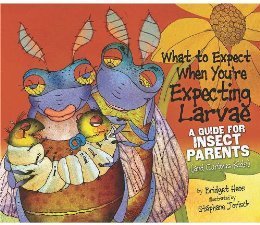 topic funny, accessible, and entertaining. Another series of books that's told in a surprising way is the If You Were a _____ (fill in the blank). Some examples of these books are If You Were a Quadrilateral, If You were a Fraction, If You Were a Compound Word, etc. These books creatively use the child as the star and has them imagine themselves as the actual nonfiction topic. Very clever. Another knock out surprising format is using a parody--Lane Smith's, John, Paul, George & Ben, nails the creative nonfiction genre. He uses the Beatles as an underpinning analogy to our United States founding fathers. Parents are pleased with the references and kids are pleased by the silliness. That's a great one to check out.
topic funny, accessible, and entertaining. Another series of books that's told in a surprising way is the If You Were a _____ (fill in the blank). Some examples of these books are If You Were a Quadrilateral, If You were a Fraction, If You Were a Compound Word, etc. These books creatively use the child as the star and has them imagine themselves as the actual nonfiction topic. Very clever. Another knock out surprising format is using a parody--Lane Smith's, John, Paul, George & Ben, nails the creative nonfiction genre. He uses the Beatles as an underpinning analogy to our United States founding fathers. Parents are pleased with the references and kids are pleased by the silliness. That's a great one to check out.
 Teaching a nonfiction subject through rhyme/meter--This is a favorite in the trade/school market. If you can use great meter or rhyme to teach a subject, then it will sell. Some glorious classic examples are Math Curse, Science Verse by Jon Sciescka, Grapes of Math series by Greg Tang, and Verla Kay's metered verse history books. One of my critique partners just sold a book that was told in rhyme that highlighted a historical parade. You never know! If you can think up a great subject and you can write rhyme well, go for it!
Teaching a nonfiction subject through rhyme/meter--This is a favorite in the trade/school market. If you can use great meter or rhyme to teach a subject, then it will sell. Some glorious classic examples are Math Curse, Science Verse by Jon Sciescka, Grapes of Math series by Greg Tang, and Verla Kay's metered verse history books. One of my critique partners just sold a book that was told in rhyme that highlighted a historical parade. You never know! If you can think up a great subject and you can write rhyme well, go for it!Assignment 8:
Go to the library and see if some of these examples are there. Are they in the nonfiction section or fiction? I've found librarians don't know where to place them. My books are often in both, but usually in nonfiction so teachers and students will have access to them when finding a subject. Ask your librarian if they know of other examples. Some other authors to look up are Robin Pulver, Loreen Leedy, and Brian P. Cleary. Check out as many as you can of various subjects that inspire you. Can you find different formats? One of each (story, surprising format, rhyming text)?Next, brainstorm at least three new ideas in your writing journal. If one calls to you, start your research and then write!
Did you find a book that didn't fit my definitions or know of a great book to check out? If so, please share!
If this post helped you, please share by clicking the twitter bird, fb like, or google plus!
Missed a few PBU posts? Click here: PBU
Published on September 10, 2013 09:36
September 3, 2013
Picture Book Analysis: Kohola: King of the Whales by Vince Daubenspeck
Because of Labor Day, I'm a bit behind this week. I don't want to shortchange you, so I'll post the next installment of PBU next week! Because I don't want to leave you hanging, I figured I'd do another picture book analysis of an awesome new picture book that would be a GREAT, AMAZING gift for not only a child but a family as well. It's entitled, Kohola: King of the Whales. Written as a folktale from the Hawaiian islands, Vince Daubenspeck masterfully weaves a tale of the journey of a young humpback whale from lonely outcast to magnificent hero that underscores the theme of being yourself and never giving up.
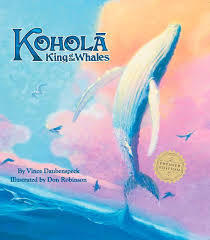 The book's illustrations are breathtaking throughout which matches the beautiful words. It's a piece of art through and through!
The book's illustrations are breathtaking throughout which matches the beautiful words. It's a piece of art through and through!
Okay, can you tell I'm in love with this book? Onto the analysis.
SPOILER ALERT! My picture book analyses will reveal the climax/ending to every story. So be forewarned!
Genre: Original folktale (the author made it up--but you can't tell it's not an actual legend because it's so well done.)
Synopsis: A loving grandfather tells his grandson the tale of Kohola: King of the Whales. Kohola is born with unusually large fins and is rejected by his peers, so he takes to exploring the deep ocean by himself. When his overly protective parents tell Kohola not jump out of the water because it's too dangerous, Kohola tries his best to obey, but his curiosity gets in the way. He uses his large fins to literally sail out of the water and soon he's a master jumper. But when some dangerous killer whales threaten his life and the lives of his clan, he uses his skill to crash down on the animals and scare them away. He tries to teach other whales how to jump out of the water, but no whale could soar the way Kohola, king of the whales could to this day even though you can see them trying.
Plot elements:
Intro: The story opens with a child seeing a whale jump out of the water. His grandfather tells him the tale of Kohola to explain why they do this.Problem: Kohola is born with extra large fins and is an outcast.

Escalating problem: Because of Kohola's large fins and athleticism, he dives very deep into the ocean causing alarm among his clan.More problems: Kohola decides to dive deep then rise out of the water which his parents forbade because it's dangerous. He goes against his parents' wishes and becomes an expert jumper.Climax--Dangerous killer whales threaten Kohola's life.Solution--Kohola uses his skill of jumping out of the water to frighten them away.Ending--Kohola protects his clan and teaches them the skill thereby gaining the respect of all whales.Folktale connection--This is why you see all whales trying to jump out of the water. They want to be like Kohola, king of the whales.
Folktales usually tell of a legend about why you see certain things as they are. I've re-written many folktales and some have been published by magazines. In every one, there is a larger than life reason why you might see animals with different feathers or coats of fur or even why an island is shaped the way it is. This tale is no different except that the author made it up himself, mirroring the style of a typical legend.
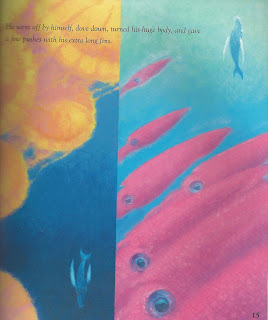 Style elements:
Style elements:
Folktale narration: Told from a third person omniscient format, this story feels old and yet not too distant so a child would be interested.Vivid language: sparkling sea, flashing storm clouds, clear shining light, crashing waves, long, clumsy fins, etc.Kid connection: The story opens with a child's question. In the middle, you see the child wanting to act like Kohola--you can feel the excitement and are emotionally attached to the story at this point as seen through the child's eyes.Great use of imagery: the killer whales are not named as such since this is told from the perspective of the whale. They are called, "dark lights" since they blot out the light when their large dark bodies swim in front of the sun, streaming through the water. He uses language like "waves of fear" as a nod to the water but also gives you the foreboding feeling.Circularity: The story closes as it opens with the child and the grandfather. You get a sense of completeness when you see the child look again at a whale rising out of the water.
If you want to rewrite an existing folktale, or better yet, write your own, this would be a great book to study as well have in your own library.
Happy reading!
 The book's illustrations are breathtaking throughout which matches the beautiful words. It's a piece of art through and through!
The book's illustrations are breathtaking throughout which matches the beautiful words. It's a piece of art through and through!Okay, can you tell I'm in love with this book? Onto the analysis.
SPOILER ALERT! My picture book analyses will reveal the climax/ending to every story. So be forewarned!
Genre: Original folktale (the author made it up--but you can't tell it's not an actual legend because it's so well done.)
Synopsis: A loving grandfather tells his grandson the tale of Kohola: King of the Whales. Kohola is born with unusually large fins and is rejected by his peers, so he takes to exploring the deep ocean by himself. When his overly protective parents tell Kohola not jump out of the water because it's too dangerous, Kohola tries his best to obey, but his curiosity gets in the way. He uses his large fins to literally sail out of the water and soon he's a master jumper. But when some dangerous killer whales threaten his life and the lives of his clan, he uses his skill to crash down on the animals and scare them away. He tries to teach other whales how to jump out of the water, but no whale could soar the way Kohola, king of the whales could to this day even though you can see them trying.
Plot elements:
Intro: The story opens with a child seeing a whale jump out of the water. His grandfather tells him the tale of Kohola to explain why they do this.Problem: Kohola is born with extra large fins and is an outcast.

Escalating problem: Because of Kohola's large fins and athleticism, he dives very deep into the ocean causing alarm among his clan.More problems: Kohola decides to dive deep then rise out of the water which his parents forbade because it's dangerous. He goes against his parents' wishes and becomes an expert jumper.Climax--Dangerous killer whales threaten Kohola's life.Solution--Kohola uses his skill of jumping out of the water to frighten them away.Ending--Kohola protects his clan and teaches them the skill thereby gaining the respect of all whales.Folktale connection--This is why you see all whales trying to jump out of the water. They want to be like Kohola, king of the whales.
Folktales usually tell of a legend about why you see certain things as they are. I've re-written many folktales and some have been published by magazines. In every one, there is a larger than life reason why you might see animals with different feathers or coats of fur or even why an island is shaped the way it is. This tale is no different except that the author made it up himself, mirroring the style of a typical legend.
 Style elements:
Style elements:Folktale narration: Told from a third person omniscient format, this story feels old and yet not too distant so a child would be interested.Vivid language: sparkling sea, flashing storm clouds, clear shining light, crashing waves, long, clumsy fins, etc.Kid connection: The story opens with a child's question. In the middle, you see the child wanting to act like Kohola--you can feel the excitement and are emotionally attached to the story at this point as seen through the child's eyes.Great use of imagery: the killer whales are not named as such since this is told from the perspective of the whale. They are called, "dark lights" since they blot out the light when their large dark bodies swim in front of the sun, streaming through the water. He uses language like "waves of fear" as a nod to the water but also gives you the foreboding feeling.Circularity: The story closes as it opens with the child and the grandfather. You get a sense of completeness when you see the child look again at a whale rising out of the water.
If you want to rewrite an existing folktale, or better yet, write your own, this would be a great book to study as well have in your own library.
Happy reading!
Published on September 03, 2013 12:13
August 28, 2013
Chieu Urban's book winners!
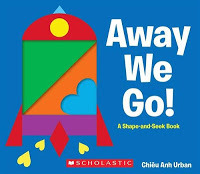 I'm pleased to be able to announce the winners of Chieu Urban's wonderful book, AWAY WE GO!
I'm pleased to be able to announce the winners of Chieu Urban's wonderful book, AWAY WE GO!Drumroll please....
TADA!

Just email me at pam@pamcalvert.com and I'll give you instructions on how to receive your book!
Hooray and congratulations! Thank you to all who participated!
Published on August 28, 2013 10:33
August 27, 2013
Picture Book University: Picture Books for Preschoolers, Toddlers, and Infants

Today I'm going to highlight a picture book that some editors are saying they're looking for: picture books for very young children--preschoolers, toddlers, infants. This particular book, when analyzed, comes in many different types, but all are simple. So simple, in fact, that it boggles the mind. And because of this, it makes them VERY hard to write and even harder to sell (if you're not an amazing illustrator as well as writer.)
SO, why am I going to talk about them? Because they are needed in the marketplace. And if you hit on a great idea, you very well could have a series potential on your hands.
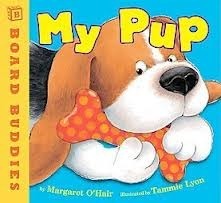 Last week, I interviewed a board book author/illustrator, Chieu Urban. If you haven't read it, check it out! In this interview, she revealed that if you aren't an illustrator, you should write a straight picture book first and then it may have a chance to become a board book later. This has happened to one of my friends, Margaret O Hair with her book, MY PUP. It first came out as a picture book and then went to board later. In her latest book, it came out as a board transitional--I highlight what that is in my picture book analysis : SWEET BABY FEET. Check it out if you haven't already. In both cases, she set out to write picture books--but they were for a very young child--ages 3 and under.
Last week, I interviewed a board book author/illustrator, Chieu Urban. If you haven't read it, check it out! In this interview, she revealed that if you aren't an illustrator, you should write a straight picture book first and then it may have a chance to become a board book later. This has happened to one of my friends, Margaret O Hair with her book, MY PUP. It first came out as a picture book and then went to board later. In her latest book, it came out as a board transitional--I highlight what that is in my picture book analysis : SWEET BABY FEET. Check it out if you haven't already. In both cases, she set out to write picture books--but they were for a very young child--ages 3 and under.So what makes these young books tick? It's all about what it's all about. LOL! Yes! The world of an infant/toddler/preschooler is close to home. Very close. Their world is usually what they see every morning, noon and night, so that's what the story should be about. Also, concept books are perfect for this age. I highlight what a concept book is in lesson 1. ABC books, counting books and question/answer books are also good for this age. Because those books are fairly easy to look up, but not easy to sell, I won't be highlighting them.
Since this is a full blown picture book story, you still have to think in terms of sixteen spreads, but you'll need to keep your word count down to between 150-300 words. Now that's not a lot of words to work with, I know. But the way to get around this is to tell your story in rhyme! Yes! Rhyme! Rhyme has been tossed around as a dirty word by editors and agents alike but I have soooo many friends who sell tons of picture books in rhyme. They sell them because they know how to write them. If your meter is just a tiny speck off, you CANNOT SELL this. I've received tons of rhyming stories for critique and let me just say, almost every author has allowed one or two lines of bad meter because they wanted it to fit, but that just won't work and you'll get a rejection.
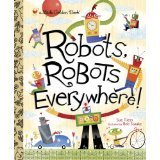 Another way to get around the word count is to use rhythm in a cycle story. In Karen Baicker's story, I CAN DO IT TOO!, she uses a repetitive line plus lots of rhythm that follows a little girl going about her day. What sets this apart are her word choices and rhythm.
Another way to get around the word count is to use rhythm in a cycle story. In Karen Baicker's story, I CAN DO IT TOO!, she uses a repetitive line plus lots of rhythm that follows a little girl going about her day. What sets this apart are her word choices and rhythm.Another writer to study is Sue Fliess. She's sold half a dozen books in the span of a few months. What's her
secret? RHYME! RHYTHM! CYCLE! Get my point? I'm going to analyze the first book that sold that launched her very lucrative career as a preschool author. She actually started writing YA's of all things, but didn't sell a book until she shifted her focus onto one of her talents--rhyme. (Probably because everyone always says not to rhyme!)
SPOILER ALERT! My picture book analyses will reveal the climax/ending to every story. So be forewarned!
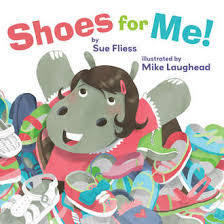 SHOES FOR ME by Sue Fliess
SHOES FOR ME by Sue FliessGenre: Preschool/toddler, Concept, Rhyming text
Synopsis: A little girl needs some shoes. But what to buy? There's way too many to choose from until her mom says they have to go and she finds the very perfect shoes!
Plot elements: A journey story.
Problem/opener: The little girl has grown out of her shoes. She needs new ones.
Major story problem: Lots of choices
Minor story problems: Makes wrong choices; shoes too tight; doesn't like some; (rule of three!)
Climax: Too many shoes to choose from! Hopeless.
Resolution/twist: The last pair to try.
Ending: Perfect fit, perfect for her.
Style Elements:
Perfect meter and unforced rhyme scheme--"Feet got bigger/heel to toe./ Time for new shoes./Off we go!" This meter and scheme is the same throughout. It's what we call an ABCCB scheme and the meter is catchy and upbeat. Funny or active pictures--Even though Sue didn't think of a cute hippopotamus as her main character, the darling anthropomorphism works. All the shoes and the activity of the little girl makes for fun pictures. The girl tiptoes, hops, taps, etc.Use of active verbs, adjectives and onomatopoeia throughout--for example, shoes clip, slip, flip, snap, sparkle, tap, etc.Use of metaphor and humor--for example, "Fuzzy, furry/shoes that quack?/I'm no duck./Please put those back."Nice rhythm that will keep kids entertained--you can feel the girl actually trying on all these wonderful shoes and see her doing the activities that the shoes would employ such as splash in a puddle.Cyclical--the ending uses the same line as the beginning and it became the title--"Shoes for me!" If you can come up with something catchy like this, you've got a winner!
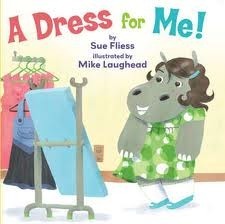
Because of the book's sales, Sue ended up selling more to the publisher and now has a series with this cute hippopotamus. She also has a line of books with Golden Books, too, all with her catchy rhyme scheme and all about things preschoolers love.
Assignment 7:
Check out at least ten books meant for preschoolers. These should be concept books or journey books or simple stories (Max and Ruby books come to mind) that don't have intricate plots and are about the world or things preschoolers/babies love.
After reading these stories, brainstorm five ideas that might be translatable into a preschooler book. Maybe it could be told in rhyme. Remember! A rhyming story is usually best if it focuses on a journey or concept. Trying to tell an intricate story in rhyme just doesn't usually work. Pick a simple rhyme scheme and stick with it. If you can't do this, use rhythm and a repetitive catchy phrase to drive your story. And don't forget the twist or surprise or cyclical ending!
Tomorrow, I will announce the winners of Chieu Urban's books, so stay tuned!
As always, please let others know about this post by clicking the twitter bird, fb, or g buttons!
Do you want to see more PBU posts? Click here.
Happy writing for preschoolers!
Published on August 27, 2013 10:26



